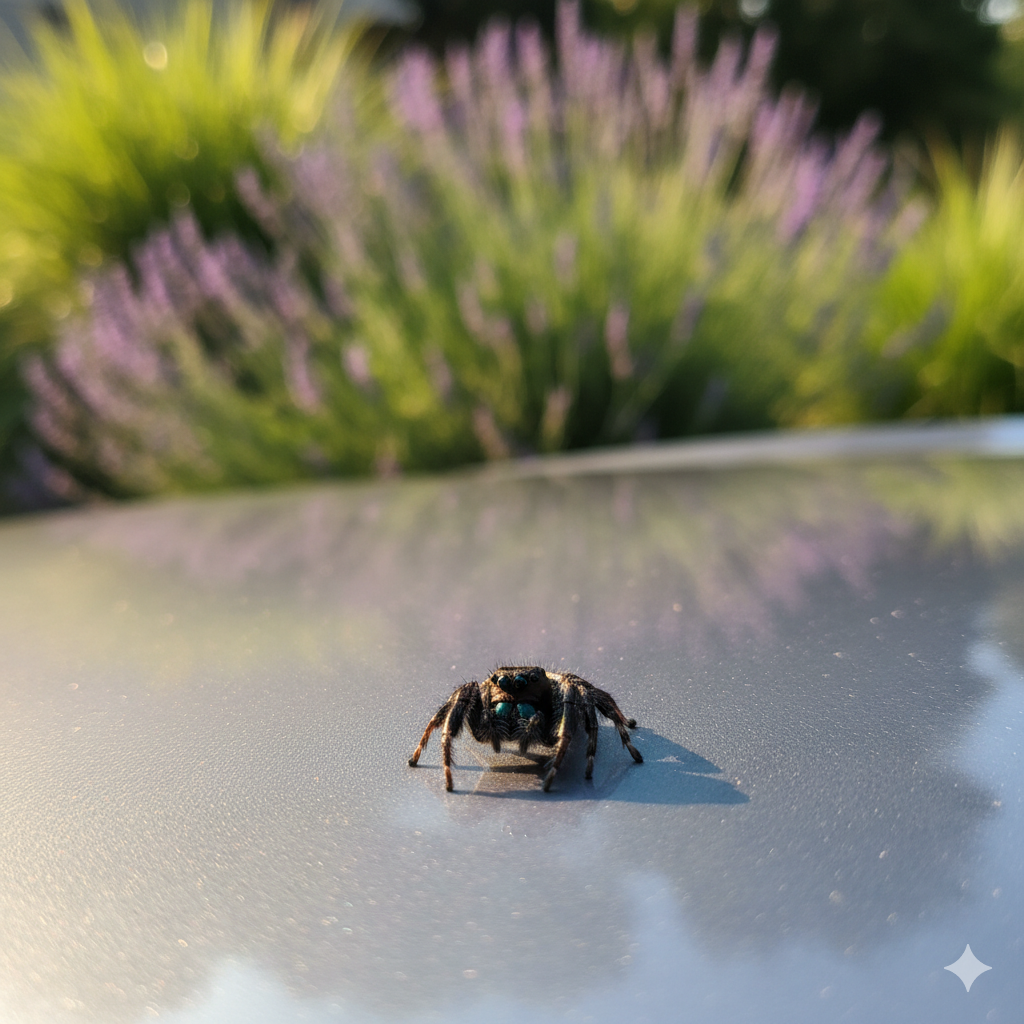The Unlikely Hitchhiker: A Bold Jumping Spider’s 54 MPH Journey and a Lesson in Backyard Conservation
Join us for an incredible true story (YT video below) of a Bold Jumping Spider (Phidippus audax) that clung to a car hood at 54 MPH. Discover the science behind its survival, the ethics of wildlife release, and a deep dive into the life of one of Virginia Beach’s most charismatic arachnids.
Here at the World Reading Club, we believe extraordinary stories are often hidden in the most ordinary moments. They unfold in our backyards, on our daily commutes, and in the quiet, often overlooked corners of the natural world. This is the story of one such moment—a tale of resilience, tiny claws, and an unexpected connection with a creature many fear, but which I came to admire: the Bold Jumping Spider.
It began not in a remote jungle, but on the sun-warmed hood of my car in Virginia Beach. After a routine drive through the city, reaching speeds of up to 54 miles per hour, I was met by an unlikely stowaway. There, perfectly poised and seemingly unbothered by her high-speed journey, was a magnificent female Bold Jumping Spider (Phidippus audax).
How could something so small, so seemingly delicate, withstand the hurricane-force winds of a highway drive? This question set the stage for a brief but profound encounter, one that culminated in her careful release into what I fondly call the “wild of the front yard.”
The Science of a Spider’s Grip: How Did She Hold On?
The Bold Jumping Spider’s survival was no mere fluke; it was a testament to millions of years of evolutionary engineering.
- Tiny Claws & Adhesive Hairs: Unlike web-weaving spiders, jumpers are active hunters. Their feet are equipped with tiny claws and dense tufts of hair called scopulae. These hairs create a powerful adhesive force through van der Waals attraction—the same principle that allows geckos to walk on ceilings. This system allows them to grip incredibly smooth surfaces, including glass and, evidently, car paint.
- A Low, Streamlined Profile: By hunkering down close to the surface, she would have minimized her wind resistance, allowing the air to flow over her rather than pluck her off.
- Pure Resilience: Sometimes, nature simply surprises us with its tenacity. This individual spider demonstrated a will to live that was nothing short of inspiring.
A Portrait of the Bold Jumping Spider (Phidippus audax)
To understand this creature is to replace fear with fascination. The Bold Jumper is one of North America’s most common and recognizable spiders, and a vital resident of Virginia Beach’s ecosystem.
- Identification: She was predominantly black, but when the bright sun caught her, the details emerged. The most striking feature was her iridescent, emerald-green chelicerae (fang bases), which shimmered like tiny jewels. Her abdomen was adorned with a distinctive pattern of white spots and lines, which can sometimes appear orange in younger individuals.
- Exceptional Vision: If you look at a photo of a jumping spider, you’ll be struck by its almost “cute” appearance. This is due to its two large, forward-facing principal eyes, which provide exceptional binocular vision and depth perception—crucial for a hunter that stalks and pounces on its prey. They have four additional eyes around their head to detect motion, giving them a nearly 360-degree field of awareness.
- Hunting & Behavior: This is not a spider that waits passively in a web. It is an intelligent, curious predator. It stalks its prey—often insects like boll weevils, moths, and other spiders—with the careful precision of a cat, calculating the exact distance before launching a powerful, silk-anchored jump.
- Habitat in Virginia Beach: You can find Phidippus audax in your garden, on your fence, or, as I discovered, on your car. They thrive in the grassy areas, shrubbery, and sunny clearings common throughout our region. They are harmless to humans; their venom is designed for small insects and is not medically significant.
The Release: A Return to the “Front Yard Wild”
The decision to release her was immediate. While she was a fascinating guest, she belonged to the living world, not a cup on my counter. The term “wild” felt appropriate, even if it was just my front yard. In an urban environment, our managed green spaces become critical sanctuaries for local fauna.
I chose a sunny, robust lavender plant near a cluster of native grasses. This location offered her everything she needed: ample sunlight to warm her cold-blooded body, complex structures for hiding from predators like birds, and a high likelihood of finding prey.
Placing her gently on a leaf, I watched as she paused for a moment, her keen eyes surveying this new, quieter kingdom. Then, with a characteristic testing of the air with her pedipalps, she scurried into the foliage, disappearing seamlessly back into the ecosystem from which she came.
A Reflection on Our Shared World
This brief encounter was a powerful reminder of the resilience and mystery of the natural world that exists just beyond our doorstep. It underscores the importance of our backyards, community parks, and even highway medians as interconnected wildlife corridors. The “wild” isn’t always a distant, untamed wilderness; it is the complex web of life happening all around us.
The Bold Jumping Spider isn’t just a pest controller; it is a symbol of curiosity, adaptability, and the sheer force of life. By sharing her story, I hope to encourage a sense of wonder and respect for the small creatures with whom we share our homes and cities.
Watch the journey unfold in the video below:
Continue the Conversation:
Have you had a memorable encounter with a creature in your own “front yard wild”? Share your stories and thoughts in the comments section below. We’d love to hear how nature has surprised you.


